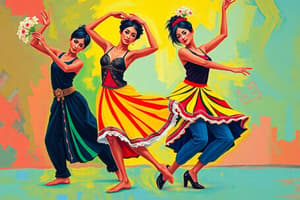Podcast
Questions and Answers
What is the primary purpose of cheer dance?
What is the primary purpose of cheer dance?
- To showcase individual talent in dance
- To promote sports teams and entertain the audience (correct)
- To teach gymnastics techniques
- To celebrate cultural heritage
Which styles are categorized under American ballroom dancing?
Which styles are categorized under American ballroom dancing?
- Smooth and Rhythm (correct)
- Smooth and Modern
- Standard and Rhythm
- International and Latin
What is a common theme for festival dances?
What is a common theme for festival dances?
- Celebration of major sporting events
- Promotion of dance competitions
- Commemoration of historical figures
- Celebration of good harvest or fortune (correct)
What aspect of dancing contributes to the sense of unity among dancers?
What aspect of dancing contributes to the sense of unity among dancers?
Which of the following is NOT mentioned as a benefit of dancing?
Which of the following is NOT mentioned as a benefit of dancing?
What is one primary purpose of dance as described?
What is one primary purpose of dance as described?
Which category does not fit under traditional dances?
Which category does not fit under traditional dances?
Which of the following is a characteristic of hip hop dance?
Which of the following is a characteristic of hip hop dance?
What differentiates contemporary dance from classical ballet?
What differentiates contemporary dance from classical ballet?
How are folk dances classified?
How are folk dances classified?
Which type of dance is described as a combination of cheering and dancing?
Which type of dance is described as a combination of cheering and dancing?
Which of the following best represents ethnic dances?
Which of the following best represents ethnic dances?
Which element is NOT a part of hip hop culture?
Which element is NOT a part of hip hop culture?
Flashcards are hidden until you start studying
Study Notes
Nature of Dance
- Dance is an expression of the body that follows rhythmic patterns and is typically accompanied by music.
- Historically, dance has evolved from primitive expressions of emotion related to significant life events.
Traditional Dances
- Includes folk and ethnic dances that reflect the culture and traits of indigenous communities.
- Preserve customs and traditions through distinctive dance steps and costumes.
Ethnic Dances
- Comprises dances from Non-Christian Filipinos, including pagan and Muslim groups.
- Includes dances from Christian and lowland Filipinos, which range from vigorous to light-hearted performances.
Folk Dances
- Classified by geographical locations; can be national or local/regional.
- Types of folk dances include occupational, religious, ceremonial, courtship, wedding, festival, war, comic, game, and social.
Modern Dance
- Less formal than classical ballet and encompasses various styles, including modern ballet and interpretative dance.
- Contemporary dance blends strong legwork from ballet with modern trunk movements.
Hip-Hop/Street Dance
- Originated in New York among African American and Latino American communities.
- Associated with rap music and characterized by four cultural elements: deejaying, rapping, graffiti painting, and B-boying.
Cheer Dance
- Combines cheering and dancing, incorporating acrobatic moves like cartwheels and back handsprings.
- Primarily aims to motivate sports teams and entertain audiences.
Ballroom Dances
- Divided into American style (Smooth and Rhythm) and International style (Standard and Latin).
- Both styles have similar categories for dances performed in competitions.
Festival Dance
- Performed during celebrations or fiestas, often to commemorate good harvests or fortunes.
- Reflects community culture and religious aspects.
Exercise Dance
- Encompasses forms of dance performed for fitness while maintaining distinct dance elements.
Importance of Dance
- Serves as a form of exercise and self-expression.
- Promotes mental and physical relaxation.
- Fosters unity as dancers often move in unison with one another.
Studying That Suits You
Use AI to generate personalized quizzes and flashcards to suit your learning preferences.





